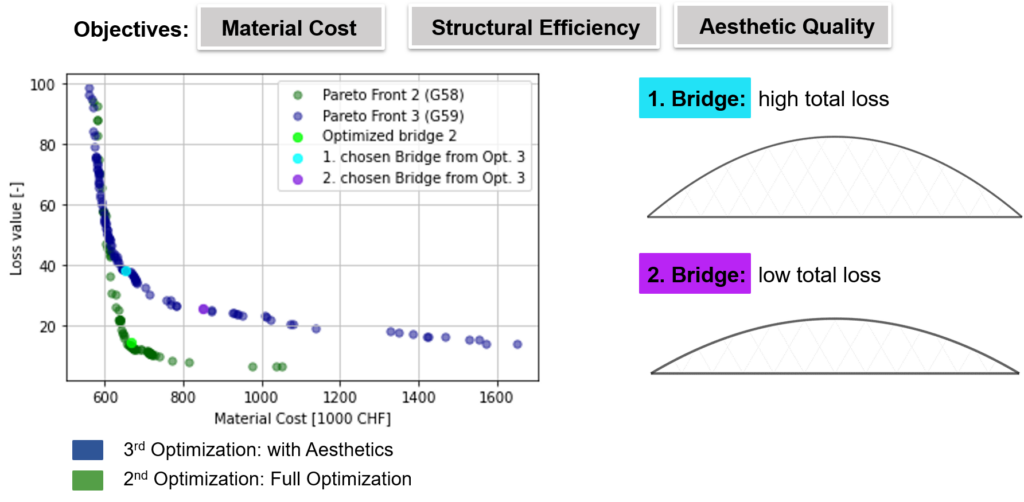Link zur deutschten Version: Performanzbasierter generativer Entwurf von Netzwerkbogenbrücken
The method of Generative Design (GD) [1] has recently been introduced to the AEC community and marks a shift in conceptualizing, designing, and construction of the built environment. The basic idea behind GD is the efficient generation of design alternatives of a parametric model of an asset, together with defined design goals (performance criteria) and constraints in order to enable stakeholders to conduct information- and data-based decision-making. To that end, GD is a design automation and optimization method, which so far has already found its way into engineering practice software, such as AUTODESK REVIT [1], and published case studies [2].
In civil engineering, the design of infrastructure assets and especially bridges would be potential candidate applications for Generative Design. On the other hand, today, no mature fully digital and thus computational design nor optimization approach for bridges is available due to the complexity of the task caused by non-linear interactions of bridge components and a tremendous amount of geometric and material design variables. Hence, bridge optimization is cumbersome, time consuming and heavily dependent on the prior experience of the individual engineer. Evaluation of design insights and patterns are shared in limited ways but inaccessible to systematic and methodical assessment by modern Machine Learning (ML) algorithms, cf. Figure 1 (left).

In order to tackle the mentioned problem of current bridge design, we initiated the “Bridge Genome Project”, which evaluates the research hypotheses that conceptual design, as we know it today, can be greatly assisted and improved by the use of modern ML methods together with databases of existing structures and GD. The concept of how this can be achieved is shown in Figure 1 (right). The idea behind the “Bridge Genome Project” is to mine information of existing structures to identify underlying patterns of bridge design (the “design genome”), which is then used as a starting point for further GD studies for new project situations. In order to establish a proof of concept, this research was concerned with network tied-arch bridges.
The proposed workflow consists of five necessary steps, cf. Figure 2:
- collection of structural data on bridges into a database;
- performing cluster analysis by unsupervised ML algorithms;
- performing predictions by regression/classification ML algorithms to generate prior bridge models;
- feed prior bridge models into a GD process via a parametric design software such as Grasshopper / Rhino [4];
- optimize design alternatives with parametric design software.

Based on a pre-processed data set of existing network tied-arch bridges all over the world, a cluster analysis was performed to find latent structures within the bridge data via two unsupervised learning algorithms K-Prototype [5] and DBSCAN [6]. A consistent structure was identified by both algorithms showing strong similarities of all bridge parameters for network tied-arch bridges that are within similar span ranges, cf. title Figure. Subsequently, a prior model is trained on the clusters, which is capable of predicting suitable bridge parameters for a new project situation in a predefined order. As this involves handling of mixed data types, the CatBoost [7] algorithm is employed here to provide regression and classification capabilities.

After generation of designs with this prior model through sampling suitable design parameters, the optimization of the parametric structural models is orchestrated using Grasshopper and Karamba3D in the Rhino 7 environment. To that end, the generative model can provide real-time structural analysis feedback for any parameter changes. Furthermore, the plug-in Octopus is applied to conduct multi-objective optimizations of the bridge parameters using the genetic optimization algorithm HypE. This study investigated objective functions concerning material costs, structural efficiency (for sake of simplicity 2D with linear elastic material behaviour), as well as a novel ML-based predictor for aesthetic quality. An example optimization result is given in Figure (3), involving (i) material costs and structural efficiency (Pareto-front marked by green dots); (ii) material costs, structural efficiency and aesthetics perception (Pareto-front marked by purple dots).
With this proof of concept study on network tied-arch-bridges, the developed multi-step ML approach for an automated GD of bridges is found to be a valuable assistance to the structural engineer, especially in the early design phases of a project. Our approach allows for an efficient structural design and optimization process of bridges and provides a template framework, which can be directly applied to other suitable data sets of other frequently used types of structures in the built environment, such as hangars or houses. The proposed ML approach allows to identify, extract and analyze design patterns contained in the built environment through the clustering step, which triggers further engineering insight but also discussions. The calibrated prior model formalizes this design knowledge and allows for sampling new designs at an early project stage. The so generated designs can then be fed to the Grasshopper/Rhino optimization loop to gain performance information (e.g. structural utilizations, deformations, but also aesthetics and sustainability aspects) in an automated manner. On the other hand, we identified a few limitations in this approach, which are the epistemic uncertainty of the prior model based on the small size and censoring of the data set for model training. In addition, the input of expertise and creativity by a structural engineer remains necessary as the machine-learning model might have learned potential unfavourable designs from the data, innovations are rare in this formulation of the GD approach, and Pareto-optimality enforces final stakeholder decision on the balancing of several performance objectives (e.g. economy vs utilization).
Michael A. Kraus
Comment this post on LinkedIn or Instagram
Literature
[1] https://www.autodesk.com/solutions/generative-design
[2] https://archistar.ai/blog/4-examples-of-generative-design-in-action/
[3] Kuhn, S. (2021): Parametric Modelling and Generative Design – A Multi-Step Machine Learning Approach for Design and Optimization of Network Tied-Arch Bridges, Master Thesis, ETH Zurich
[4] McNeel, R., & others. (2010). Rhinoceros 3D, Version 7.0. Robert McNeel & Associates, Seattle, WA.
[6] https://scikit-learn.org/stable/modules/generated/sklearn.cluster.DBSCAN.html
[7] Dorogush, A., Gulin, A., Gusev, G., Kazeev, N., Prokhorenkova, L., Vorobev, A. (2017): Fighting biases with dynamic boosting, arXiv:1706.09516.